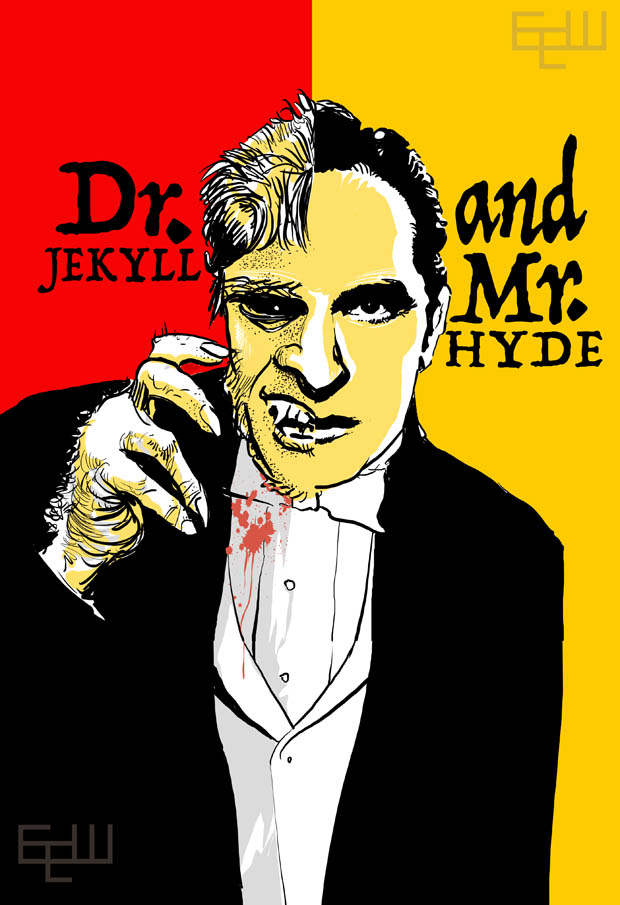Dr. Jekyll and Mr. Hyde - 1931
A personality "split" taken to a whole different level.

Frederic March got a best actor Oscar for his portrayal of the scientist who bites off more than he can chew when he concocts a potion that can split him into his "better" and "animal" selves. The result is a beatific Frederic March (almost glimmering under the lights early on as shown to us by director Rouben Mamoulian) as a brave, helpful and thoughtful Henry Jekyll, scoffing at the restraints of tradition and seeking to push out the boundaries of science. Whether the new science he is practicing is safe or not is a big question he doesn't pay enough attention to, and the results are malignant and horrifying in a uniquely 1930's Gothic way.
Though the tale itself is shown to us as taking place in a frequently fog-bound and gas-lit 1880's London, the visual concept is right in the same vein as the other early 1930's "shockers" like Dracula, Frankenstein, The Mummy, etc., where Lon Chaney's silent-movie template of transformative makeup was followed and utilized right into the burgeoning sound era. A particular aspect of Frederic March behind the makeup of the bestial Mr. Hyde is that with each transformation, he actually appears worse, and each episode of his worsening appearance marks the accelerating degeneration of Jekyll. Mamoulian tells us the story in a visual way that is so strong, and so littered with visual cues that, despite being a full-bore "talkie" loaded with dialogue, the film also has a duel identity of also being something like a silent film with techniques of storytelling derived from that era which had only passed on a few scant years before Dr. Jekyll and Mr. Hyde was released.
Miriam Hopkins gives an amazing performance as the barmaid Ivy, a woman who is attacked in the street and the beating is interrupted by Jekyll. He gently tends to her bruises and she attempts to latch on to him, and their brief association in which she frankly offers physical intimacy to keep him close, and he defers, soon leads to Ivy becoming the tormented prisoner of Mr. Hyde. Her entrapment transcends the physical limitations of a brutal "lover" but becomes a claustrophobic psychological imprisonment as well. Miriam Hopkins doesn't get as much screen time as March (who is after all playing two roles) but hers is the only other screen personality that in Dr. Jekyll and Mr. Hyde has equal weight to March's, and she gives a sometimes excrutiating portrayal.
Mamoulian's Dr. Jekyll and Mr. Hyde is possibly the best screen version of the Robert Louis Stevenson story despite dated elements, and it is peppered with a visual style that retains some of the extraordinary skills developed out of the just passed silent film era, but cleverly mixed with the demands of the new "talkie" films and the stage bound audio recording technology of 1931.
What's Recent
- The Devil and Miss Jones - 1941
- Sinners - 2025
- Something for the Boys - 1944
- The Mark of Zorro - 1940
- The Woman They Almost Lynched - 1953
- The Cat Girl - 1957
- El Vampiro - 1957
- Adventures of Hajji Baba – 1954
- Shanghai Express 1932
- Pandora's Box – 1929
- Diary of A Chambermaid - 1946
- The City Without Jews - 1924
- The Long Haul
- Midnight, 1939
- Hercules Against the Moon Men, 1964
- Send Me No Flowers - 1964
- Raymie - 1964.
- The Hangman 1959
- Kiss Me, Deadly - 1955
- Dracula's Daughter - 1936
- Crossing Delancey - 1988
- The Scavengers – 1959
- Mr. Hobbs Takes A Vacation - 1962
- Jackpot – 2024
- Surf Party - 1964
- Cyclotrode X – 1966
Original Page February 2024 | Updated June 8, 2024